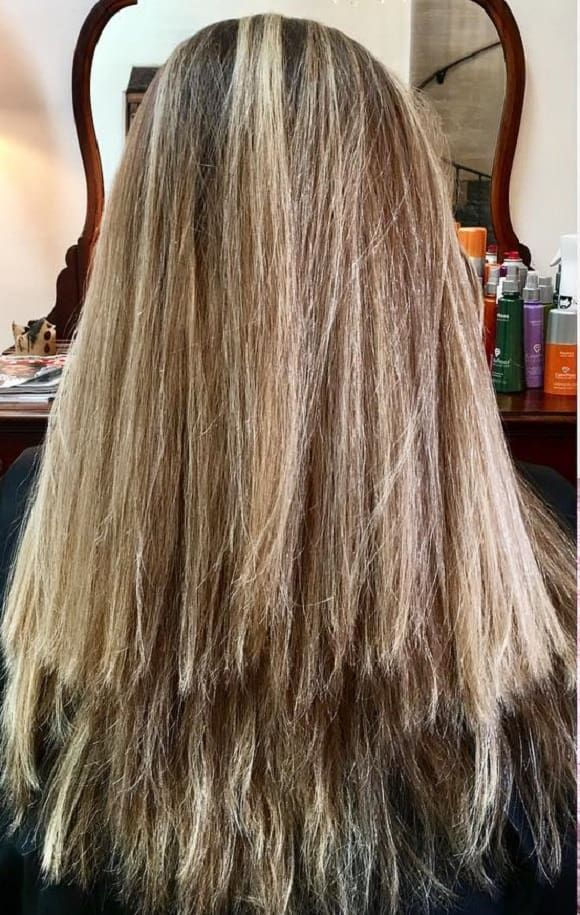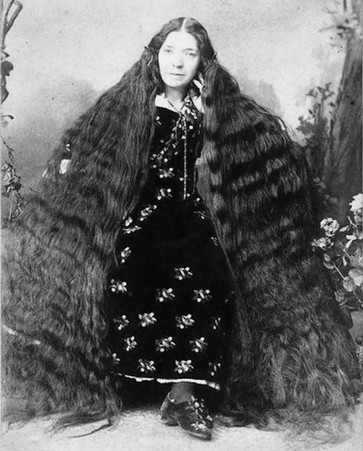The Hair Care Lies That Secretly Ruined an Entire Generation
- Katherine Haircare

- Jun 27
- 11 min read
An entire generation sacrificed their hair to a lie—and chances are, you’re still living by it.
For much of human history and across cultures, long, healthy, thick hair, tended to be the norm. Much more so than today, when you have droves of people losing hair in their 20’s, or unable to grow it past shoulder length due to continued breakage. And this in a time when hairdressers, commercial hair products of every kind, and hair styling tools are more accessible than ever before. What gives?
What did we lose as a culture, when we threw out our grandmother’s - and ancestors’ - hair care techniques, and began following the advice of corporations instead?
And don’t write this off - this is an effect that is still happening today. Personal stories abound from modern day cultures, such as India. In India, traditional hair care practices like hair oiling are still, and many people there have thick, long, beautiful hair. But what we can see is that when people from India are immigrating to the West, or just adopting more “modern” Western hair care techniques, their once beautiful, long hair, is falling out and breaking off. What gives?
What we are pinpointing here is something I am going to call the cultural “Burn Cycle.” Basically, when any kind of revolution in society occurs - be it social, ideological, technological, it usually destroys much more than it intends to. Within a couple generations, the knowledge and traditions that took hundreds or thousands of years to grow and blossom are not only disrupted, but completely wiped away.
This “cultural burn cycle” applies to bigger turning points in human society, but in this case, let’s apply it to the way humans (at least here in the West) care for our bodies and our hair.
For all of human history until the last century, knowledge of how to care for one’s hair was generally passed down from mother to daughter, or father to son. These were techniques that may have been slow, or inconvenient by modern standards, but they worked, which is why they stood the test of time. Things like hair oiling, gentle detangling, avoiding drastic hair cuts, and gently styling hair in a way to keep it tucked away and protected from the elements. Using natural, earth-based ingredients to care for one’s hair. More than all this, the main jist of historical hair care was viewing one’s hair as a sacred extension of your own body. Something that wasn’t merely a cosmetic appendage, or a fashion statement, but a part of your body that deserved respect and gentle care - not forcing it into constantly changing fashion trends and frying it into submission.
With the massive political, social, and familial changes of the 20th century, there was something big happening in the world - much bigger than just beauty and hair care. This was a complete reordering of how we as a people view knowledge. Is it something to be passed from mother to daughter, treasured for generations, or is it something we get from constantly evolving “experts”, or more likely, money-hungry corporations that promise big things? I would suggest the latter is what has happened.
Now before we get into bashing modern hair care ideas let’s acknowledge some of the good things that have come with time. Because definitely, some positive things have happened with modern attitudes about hair. First of all, there has been a widening of what are considered to be acceptable beauty standards. This probably has to do with the internet exposing people to a wider range of people and ideas than ever before.
Modern hair philosophies have possibly also given more freedom to spend less time on one’s hair if you so desire. Commercial hair products, heat styling tools, and shorter hair cuts can definitely help with that, if saving time is your only priority. Finally, for positives of modern hair care ideas, there is also perhaps a greater appreciation - by our current day - of different racial hair textures. This has been a long time coming, and arguably the culture around hair conformity was worse in say, the 1950’s, than previously in history - but I’m definitely not an expert on this.
So what I am suggesting in this video is not that the 20th century “hair care revolution” didn’t achieve anything good, or open up more possibilities for some people. It did. But what I am suggesting is that like any revolution, this created a sort of “Burn cycle”, where much more was lost in the process than what was gained, and that hair care traditions that worked were burned away and forgotten in the course of one or two generations.

So let’s jump into the top 4 pieces of hair care advice that secretly ruined an entire generation. Because I think in concepts, I am going to break this down into 5 damaging hair care ideas, which led to a whole lot of on-the ground damaging hair practices, that I will elaborate on in each section. Keep watching until the last point because it is a fairly unexpected one!
One more thing before we get into it…
I’m selecting 20 brave women to get my 4.9-star Herbal Hair Growth Oil, and 6 months of hair consultations completely free.
So if you’re struggling with breakage, thinning, or hair that just won’t grow no matter what you do, I want to invite you to the Katherine Haircare Herbal Hair Growth Challenge.
Here’s how it works:
Click the first link in the description, and you’ll be asked to share your hair story—what you’re struggling with, what you’ve tried, and where you want your hair to be.
You’ll also upload a quick photo of your current hair so we can track your progress together.
Then I’ll hand-select 10-20 women to receive a free bottle of my Herbal Hair Growth Oil—along with special instructions for faster, fuller results.
Over the next few months, we’ll track your progress, and I’ll personally guide you with advice to overcome your unique hair challenges.
And at the 6-month mark, we’ll choose one woman with the most powerful transformation to receive a generous year’s supply of oil, completely free, to keep the progress going.
Even if you’re not selected, we’ll send you a 15% discount code as a thank-you for applying.
So what’s the catch?
Full transparency - this IS a marketing campaign.
Your transformation will become a cornerstone in the Katherine Haircare movement.
A living, breathing example that real results ARE possible.
In a world of false promises and lackluster results, women with similar struggles NEED to see proof, and your journey could be the one that helps them realize that hope isn’t lost for their hair after all.
So if you’re brave enough to share your story, this is your chance to see real results, get personalized advice, and finally get hair that you’re proud of – without having to pay to test it out.
The submission period is only open for a limited time! so if this is you, pause the video now, click the first link in the description, and let’s help you get the hair you’ve always deserved.
Let’s get back into the top 4 “Bad Modern Ideas About Hair “
Bad Advice #1. You are Gross, Stinky, and Dysfunctional (Buy Our Product to Fix it)
Let’s face it. So much of the movement we saw towards commercialized, made in a lab, artificially perfumed products beginning in the 1930’s and 40’s was due to really smart mass marketing. This was marketing that played on what are most people’s natural insecurities. For example, the fear that one might smell bad to other people without realizing it. And that the only way to prevent this is to buy said company’s perfumed products and use them regularly as a sort of insurance policy.
This kind of mass fear based marketing was also used in a larger and more insidious way. That is, to convince people that their bodies were naturally dirty, full of disease causing bacteria, and frankly, dysfunctional. That is, you couldn’t trust your scalp to not produce way too much oil, you couldn’t count on not having dandruff, and you couldn’t count on having healthy hair. Rather, negative disease states to do with the scalp like dandruff, frizzy or weak hair, or balding, were the default. That is, unless you purchased these heavy-handed, made in a lab chemical-concoctions, to “correct” the mistakes of nature.

In other words, your hair and scalp’s natural state was to be completely dysfunctional, and the only way to band-aid this, was with external, artificial products.
Now, am I saying that we should never use hair products? Of course not! People throughout history have used all sorts of products on their hair and scalp. But I would suggest that there are two big differences with a healthy, discretionary use of products, to the kind of mass fear marketing beginning in the 20th century. One - products throughout history were generally used with a healthier attitude. My hair, body, etc, are not dysfunctional, they are smart and perfect the way they are. Perhaps there are challenges, or things I would like to improve, but the goal of any product should be to mobilize and encourage the body’s own drive towards health and homeostasis.
This leads me to reason number 2 that a healthy use of products is different than the fear marketing pushed in the 20th century: Products should almost always be based on natural ingredients that are as unprocessed as possible. Why?
Because this is what our bodies are designed to recognize and respond to. Yes, herbal and natural treatments can treat certain symptoms, but they usually do so in a more holistic way, that can adjust based on the individual’s needs. Quick example. Lavender essential oil can be added to hair treatments of all kinds, and is known as a balancing oil. In other words, if you have too much oil production, it can help calm it down, or if you have too little oil production, it can help encourage more oil production. To me, this suggests that the lavender oil is not simply band-aiding specific symptoms, but rather helping mobilize the body’s own desire for healing and homeostasis.
Bad Advice #2. Your Hair is Merely a Fashion Accessory
Second piece of hair care advice that ruined an entire generation: Your hair exists merely as a fashion accessory, or a sort of cosmetic appendage. In other words, your hair is much like your clothing or accessories - lifeless in itself, dead, and meaningless except insofar as it allows you to follow the latest trends, or to suit your personal whims of how you want to present yourself.
Compare this to the traditional, holistic view of hair, which is that hair is an extension of oneself, a reflection of our inner being and state of health, and that it is deeply personal.
Now, here is what I am not saying. I’m not saying that hair was never viewed as a way to express oneself or even to follow fashion trends in history. Rather, that simply wasn’t the only thing it was - it was much much more.

In the modern day, we have kind of taken the full reality of what hair is, and flattened it down to what we consider the most important thing - how it looks outwardly. Therefore, we are willing to do all kinds of objectively harmful things - chemical hair dyes, curling or straightening treatments, heat tools, aerosol hair spray, back combing, etc - all to try to achieve a certain look.
What every person who values the long term health of their hair and inner being needs to do, ideally, is to develop their own sense of who they are, and what their hair is, on the deepest level. They need to get a sense of what is good for them, ultimately, and what is good for their hair. And then, when the desire arises to do something to your hair to achieve a certain look - which is natural - we can weigh this against the deeper understanding of what our hair truly is. And this will look different for everyone.
For me, since I view my hair as an extension of my body, and a living thing, I won’t ever use heat on it, especially in the form of direct heat like straighteners or curlers. Why? Because I wouldn’t apply a hot iron to any other part of my body, so why my hair? Just because I can’t feel immediate pain from doing so like I would on my skin, doesn’t mean there isn’t damage occurring. But I do choose to use other, non-damaging techniques to style my hair and achieve the look that I desire. It’s all about determining where that line is for oneself.
Bad Advice #3. Hair Should be Dramatically Shaped Through Cutting
One of the big changes that began happening in the 20th century was this idea that hair should be dramatically shaped through cutting. Now, yes, women have always wanted to shape and style their hair to make a fashion statement, or to suit their face. However, in most times and cultures, this styling and shaping was achieved through the way the hair was styled, not the way it was cut. Generally, people believed that hair was best kept at relatively the same length - meaning, no layers. This also helped to keep ends healthier, since there is strength in numbers, and it helped to avoid the modern problem of faddy modern haircuts with lots of layers causing a nightmare when needing to be grown back out. Hair cuts like this also make protective styles more difficult to achieve - more on that in point 4.

Finally, this belief leads to a culture in which it is considered completely normal to cut our hair dramatically to suit a transitory mood or fad, and while this is of course perfectly fine and up to each individual, having a culture where this is viewed as normal and even encouraged can be problematic. It’s entirely normal to use hair to suit our moods and fancies, but ideally, this would be achieved through more minor changes that aren’t permanent, like styling it differently, for instance.
Bad Advice #4. Hair Should Always be Worn Loose
This is a big one - and on the surface, it may not seem like such a big deal. What’s the problem with wearing hair loose?
Well, nothing, of course! However, a society that defines loose hair as the default option, and everyday updos typically as something we only use when we are busy or frazzled, makes a huge difference in how we view and care for our hair. It will probably also lead to generally, shorter hair lengths being viewed as the norm, because longer hair can be a lot more inconvenient to wear loose on the daily.
The historical mindset of hair being an extension of one’s self and not merely a cosmetic appendage, as we talked about earlier, typically goes hand in hand with wearing hair up in protective styles more often. In other words, if my hair is a part of me, then it’s not just an accessory that needs to be flaunted all the time in order to look put together. But what’s the problem with wearing hair loose all of the time?

The main result of a culture that wears hair loose all the time will be the overuse of styling of all kinds. Hair dyes, chemical treatments, frequent shampooing, tons of styling products, heat tools, you name it. All of these will be (and are!) overused in a culture that views loose hair as the normal, default option. The fact is that updos, braids, and protective styles are not only more protective for the hair by keeping the fragile ends tucked away, but it also means that all of these afore mentioned damaging practices will be used less often, since updo’s, or even braids, hide so much more and don’t require a ton of processing on the hair itself to look nice.
So with all that said, this has been the top 4 pieces of hair care advice that ruined an entire generation. If you’d like to hear more about some of the solutions to these hair care problems, I have a pretty large library of hair care videos that can give you more than enough to get started. I also have a free Hair Growth Cheat Sheet that you can sign up for on my website, with some of my favourite all-natural recipes - all free! Finally, if you are interested in a chance to try out my herbal hair growth oil for free along with 6 months of consulting with me, be sure to sign up for my hair growth challenge - it’s the first link in the description.
Thanks for joining me for this investigation of our culture’s hair philosophies!
If you’re into natural hair care, vintage beauty, or historical hair secrets, make sure to subscribe to my email list!
When you sign up you will get my Free Hair Growth Cheat Sheet where you'll learn:
4 Easy-to-make recipes that work 10x better than commercial products
Historical hair secrets that helped my grow past my hips
Exactly why the products you've tried before have let you down
How to escape the "hair care hamster wheel" for good
The 3-phase hair growth cycle (know this or stay stuck at your current length)
Sign up below the comments!



























A Mahadev Book ID opens the door to a smoother, smarter, and more secure online betting experience. With a verified ID, users gain access to a simplified platform designed to provide fast navigation, reliable features, and enhanced safety measures for every wager they place. Whether you're exploring new games or looking for a seamless way to manage bets.
Mahadev Book redefines the online betting journey by giving users a platform built on reliability, clarity, and consistent performance. With its intuitive interface and secure system, players can explore betting options without feeling overwhelmed or uncertain. Every feature is designed to support informed decision-making, helping users approach each wager with a sense of control and assurance.
best iptv Elevate your entertainment with 4K IPTV streaming that brings sports, movies, and TV shows to life with vivid detail. best iptv
This was one of those rare blog posts that make you stop and think. The clarity and creativity really stood out! I follow diverse sites for similar inspiration — TheStyleMyHair.com for trends, ShayariRead.com for poetry, and CarCollectionWorld.com for cars. LoveShayariPath.com and ShayariPath.com always make my day brighter. NYCricket.com keeps sports fans thrilled, while AInfluencersGoneWild.com brings humor and culture. SnapchatPlanetsInOrder.com decodes social media perfectly, and ACourierTracking.com with Juction.com adds value to my online time.
Reading this blog is always worthwhile—the positive energy feels just like what I expect from terrificwishes.com. The factual updates remind me of thematchplayerstats.com, while the playful tone matches what you’d find at chillguymemes.com. The precision is as strong as at officersdetails.com, and the spiritual wisdom aligns perfectly with theduaforyou.com. Interesting concepts make this space as captivating as greblovz2004free.com. Your effort shows in every post!